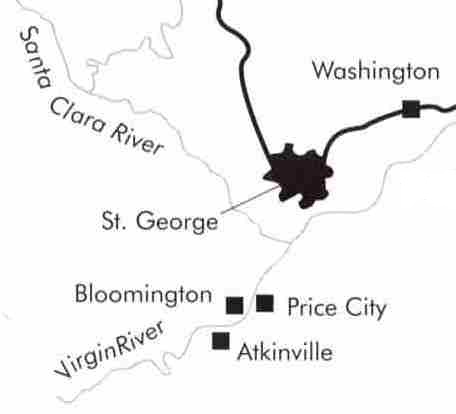
WASHINGTON COUNTY HISTORICAL SOCIETY (Washington County, Utah)
PRICE CITY, UTAH
(formerly Heberville)
LOCATION
It is the area of Bloomington now known as "The Ranches" on the southeast side of the Virgin River.
HISTORY
Heberville, named after Heber C. Kimball, was founded in January 1858 when Joseph Horne and his companions were sent to establish a cotton farm along the southeast side of the Virgin River. The cotton grown in Washington had not germinated properly due to the alkali soil and Brigham Young wanted to do some further experimentation before launching a full-scale cotton growing initiative.Horne obtained cottonseed from settlers living in Santa Clara and Washington. On May 6, 1858, the cotton farmers started sowing cottonseed in the red fertile soil. The summer heat was blistering and the Virgin River flooded twice, destroying their dams. Friendly natives helped rebuild the dams and canals and Horne's men reciprocated by helping the Indians with a similar project about six miles south along the Virgin River. But Horne's group was moderately successful and in November 1858, they delivered 575 pounds of cotton to the Tithing Office in Salt Lake City.
The second year they added corn and sugar cane to their crops. But storms destroyed their dam and irrigation ditches. The people became discouraged and the community was abandoned.
Under the direction of Erastus Snow, the community was reestablished in 1863 as a cooperative farming community. This try only last four years before the community was abandoned again.
In 1872, Elder Erastus Snow encouraged several of the local brethren to create a cooperative farming company and to reclaim the abandoned Heberville farm. They purchased the property from the previous owners through the issuance of stock interest in future earnings. Several families, including the Atkins, Gardners, Sanders farmed there over the next two years. But their coop began to unravel as families again abandoned Heberville for other settlements. The high cost of irrigation appears to have contributed to the decline.
Brigham Young changed the name of the community to Price City in 1874. He instituted the Price City United Order there with Milo Andrus as its superintendent and Patrick H. McGuire as secretary. The organization only existed from 1876 to 1877 before its dissolution and the winding up of its business.
The Price City Ward was organized on January 18, 1879. It served the people of Price and Bloomington. The Price City Ward was disorganized in 1904. The Price City Chapel was torn down in 1908 and Price City essentially disappeared.
HISTORIC SITES
Price City ChapelHeberville Co-operative Farming Company
Price City Co-operative Farming Company
PHOTOS
TBDREFERENCES
OnlineUtah.com article about PriceWashington County Chapter, Daughters of the Utah Pioneers, " Under Dixie Sun".
1950 with 1978 Supplement.
Pages 121-123, Supplement Page 11.
"History of Bloomington Utah"
by Carolyn Reinbold
Unpublished paper, 1994
"Virgin Water: Below the Confluence"
by Richard Kohler
Pages 3-6 (Heberville) and 7-8 (Price).
To view, click here
"From the Green Hills of England to the Red Hills of Dixie:
The Story of William and Rachel Thompson Atkin"
Book by Reid L. Neilson
with a Forward by Susan Easton Black
Pages 76-77
See the information page.